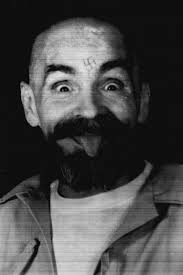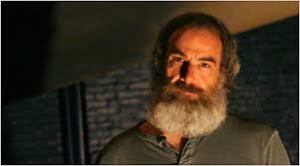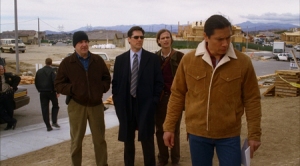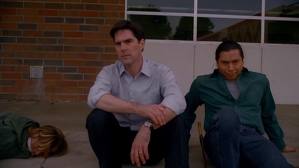What Happens After the Credits? Every episode of Criminal Minds ends with the capture of a serial killer. The audience watches as Hotch or one of his team members handcuffs the killer and we applaud a job well done. But after going on a Criminal Minds binge last week consisting of eight episodes with a break to make popcorn, I couldn’t help but wonder what happens to the killers once the credits start rolling. Criminals Minds is a 45-minute show, but I wonder what would happen if it lasted an hour… If the creators extended it 15 minutes, what would the audience see? First, the killer would be taken to prison in a speeding cop car. Hotch and Morgan would stand with smiles on their faces; they got another murderer off the streets. Next, the audience would see a shot of the end of a trial (because no one actually cares what happens during the rest) as a jury delivers a verdict: guilty. The members of the BAU who attended, most likely boy genius Reid and intellectually curious Gidion, would look unfazed—obviously the guy is guilty. But their ears would perk up in preparation for what they actually wanted to hear: life in prison or the death penalty. In Criminal Minds, the killer would always receive the death penalty (unless the criminal plead not guilty by reason of insanity, then they might be okay, or if the trial takes place in a state that abolished the death penalty) because the criminals are always serial killers. They are not people who accidentally hit someone with their car or pushed someone down the stairs. These are people who mutilate, rape, and torture because they need to, for pleasure, to fulfill some sexual fetish, or maybe because they’re bored. They don’t feel remorse. They will, every time receive the death penalty because 1. They felt justified to take innocent lives and 2. The majority of people in the country actually support the death penalty (63%!). I was shocked; I’m a strong proponent for the abolition of the death penalty and after doing countless research papers on the subject, I do not understand why capital punishment still exists. But I digress. So basically, I established that in the fifteen minutes the audience loses to “The Stalker”—the show that airs post criminal minds—we would see a killer disappear in a cop car, stand at his trial, and hear his (death) sentence. This is what I think we would see based off my seven years fanatically watching the show. But I wonder, is this what we should see? I feel strongly against the death penalty, so I would have to say no–the show should not end with an execution. I will not bore you with too many facts about why the death penalty should be abolished, but I have attached a link to a research paper on capital punishment that I wrote in my freshmen year at the University of Michigan, called Death of Capital Punishment. If you take one thing away from that paper it should be this: capital punishment is not fools proof. There will never be a way to know for certain whether someone is guilty or not, so by enforcing capital punishment this government risks putting innocent people to death. Since 1973, 146 people have been exonerated from death row. In other words, 146 potentially innocent people would be dead right now if evidence had not surfaced questioning whether or not these criminals actually committed a crime. Getting 100 guilty people off the streets is not worth killing one innocent one; capital punishment has no place in this country, nor should it have a place on Criminal Minds.
The Tribe: Is it Really like the Manson Family?
To Preface: I am not by any means an expert on the Manson Family, just an interested college student. The following post is an opinion based on facts, but please do not mistake my opinion for fact.
Charles Mason
Criminals Minds episode “The Tribe” has been said to mirror the events of the Manson Family—a pack of murderers led by passionate leader Charles Manson. Born in Cincinnati, Ohio to an irresponsible 16 year old, Manson’s childhood was far from ideal. His mother didn’t have the means or the desire to care for him, so he had to constantly move between the homes of his extended family. In one account, Manson’s mother actually sold Charles in a café for a pitcher of beer…I don’t think she was receiving any mother of the year awards. Manson remained missing for days before his uncle found him to bring him home. Manson’s unstable and unsafe childhood fostered a burning desire to receive attention and feel love—he achieved that through the devotion of his followers and their willingness to kill.
Charles Mason and Jackson Cally
In order to determine how accurately “The Tribe” portrays the events of the Manson Family, I watched the episode a good 6 or 7 times. Each time, I became more and more impressed by how closely the writers stuck to Manson’s actual life. Like Manson, the leader of the cult in “The Tribe” (Jackson Cally, portrayed by Chad Allen) never really had a home—he spent his childhood moving in and out of foster care. Cally was also cunning, manipulative, and refrained from participating in all of his cult’s crimes—just like Manson. In the episode, Morgan actually uses Manson as a comparison: “Like Manson, Cally has been forced to become an expert profiler of sorts. He reads the people around him.” These people that Manson and Cally “read” are not the victims; they read their followers. Cult leaders like Manson and Cally profile people around them to determine whom they can push, and how far they can push them.
Race Wars
Despite the eerie similarities, the most well executed parallel between the episode and real world events was not the personality characteristics of Cally and Manson, it was the leaders’ motives: both Cally and Manson wanted to start a race war. In 1968, right after the Beatles came out with their White album, Manson determined that a race war would occur, and he called it Helter Skelter (one of the song titles on the Beatle album). He believed that black men would retaliate against whites—killing every white person in their paths until white people ceased to exist. Manson predicted Helter Skleter would occur in the summer of 1969 and when it didn’t, he decided to do something to initiate it: “The only thing that blackie knows is what white has told him” he explained to his followers before ordering them to murder four adults in Beverly Hills, “I’m going to have to show him how to do it.” Manson “knew” a war was coming—so he decided to initiate it.
“The Tribe” follows a very similar sequence of events. When the BAU apprehends Cally’s cult, they do so in a schoolhouse where his followers were planning to kill a classroom of Native American students in the Apache reservation. Cally ordered his devotees to do this because like Mason, he wanted to start a war. Only instead of a Helter Skelter between all the black and white people in the world, Cally wanted to initiate a war between the Apache Indians and the all white ADU (American Defense unit).
The Difference
There was one component of this episode that I found especially interesting: white Cally and his all white followers were fighting for the minority. Cally’s cult wants to trigger this war so the Apache fights the ADU for their people and their land. Manson, on the other hand, fought for the people like him—the white people. I don’t have any epiphanic thoughts as to why the writers of Criminal Minds chose to execute the show in this fashion, probably just creative expression, but I thought it was a discrepancy worth noting.
With all things considered, writers Jeff Daivs and Andrew Wilder and director Matt Earl Beesley did an excellent job creating a fictional representation of a very real story.
The Why of Criminal Minds
The Why: Why do I watch Criminal Minds and why do other people watch Criminal Minds?
Let’s start with me. I started watching Criminal Minds when I was in eighth grade—a little bit younger than the recommended age to watch such a violent show (oops). It was on TV while I was doing my homework in my kitchen and instantly caught my attention. The brilliant criminals intrigued me and I wanted to be like the young, attractive FBI agents who always managed to outsmart them.
Why did the killers kill? I wanted to know so badly. Most of the serial killers in the show came from broken families and abusive childhoods, so a big part of me wanted to attribute their behavior to the environment in which they grew up. But I’ve known plenty of people who grew up in less than ideal situations—divorced parents, deceased family members, abusive homes, and they don’t go around killing people. So maybe these remorseless criminals kill because their brains are just wired differently than individuals who refrain from killing. Is it nature or nurture that turns people into serial killers, or a mix of both? Probably the latter, but I don’t want to turn this into a nature vs. nurture conversation. But debate aside, wondering why killers kill played a large part in my continued interest in the show. While my infatuation with the criminals never faded, my interest in how the agents managed to catch the killers grew. How did they catch these meticulous killers time and time again? I loved being taken through the process of analyzing the crime scene, studying victims, profiling the unsub, and reaching a conclusion.
Despite my unending support for Criminal Minds, it does not receive all positive reviews, even from its star actors. Mandy Patinkin, who once stole the show for how deeply he cared about the victims and his constant desire to find out why events happened as they did, abruptly quit in 2007: “The biggest public mistake I ever made was to choose to do Criminal Minds in the first place” Patinkin expressed, “I thought it was something very different… It was very destructive to my soul and my personality.” Patinkin basically believes that Criminal Minds’ only purpose revolves around captivating viewers with violence. Those who oppose Patinkin, people like me, instead see the show as a psychological thriller; we watch as brilliant agents outsmart criminals who are often even more brilliant.
Once I discovered Patinkin’s distaste for the show, I decided to do a little more digging. One article in particular caught my attention: American TV’s love affair with serial killers. In it, the author (Ellen Gray) essentially discusses the American peoples’ obsession with crime shows. About Criminal Minds in particular she writes, “I’ve never had much use for shows like CBS’ Criminal Minds, which traffic in our darkest fears in less interesting ways” When she says “less interesting,” she compares Criminal Minds to shows like American Horror Story and Sons of Anarchy.
Ellen Gray made me think: Criminal Minds really doesn’t have much depth. Sure, some people like the violence while some despise it, but other than that the show is pretty simple— a murder happens, FBI intervenes, criminal loses. But what if each episode had a punishment phase? What if after the arrest there was a trial that would decide the serial killers fate? Once life in prison and capital punishment enter the realm of a TV show, debate will inevitably follow. I bet that would make it more interesting.
Read more: What if Criminal Minds was an hour?
Despite the not so perfect reviews, I will continue to be an avid Criminal Minds supporter. Fortunately for me and all the other Criminal Minds addicts out there, the show brought in 11.96 million live viewers for the season finale last year, so I don’t think it’s going anywhere any time soon.
The What, Where, When, Who of Criminal Minds
Spoiler Alert: In order to effectively communicate what happens in a typical episode of Criminal Minds, I am using episode 16 of season 1, “The Tribe” to provide concrete examples. If you don’t want to know what happens, stop reading now!
The What:
Criminal Minds takes humanity’s darkest fears and plasters them on network television for the world to watch. The show revolves around a team of agents in the Behavior Analysis Unit (BAU) of the FBI as they profile serial killers—or as the BAU calls them, UnSubs (Unknown Subjects) in order to determine why the killers kill and how to catch them. Each episode begins with some sort of inspirational quote, followed by an image of the will-be victim doing some normal activity (like putting a child to bed, driving, or socializing at their place of work). In the episode “The Tribe,” the camera shows five young adults partying at seemingly secluded house; little do they know their lives are about to be taken from them.
Read More: “The Tribe,” is it really like the Manson family?
After introducing the victims, the unsub makes his presence known (the unsub is very rarely a female, so I will use “his” to describe the unsubs throughout this post). Although the audience never really sees the unsub kill his first victim, we know a murder has occurred because the police either find a dead body or get a call because someone else found a dead body. Once multiple murders occur in an “unusual” way, the local police force calls the BAU. For the record, by unusual I am not trying to say that any murder is usual. But for the show’s sake, unusual means multiple murders either with the same victim type, the same abnormal kill type (like drowning), or the same evidence at the crime scene. After the BAU gets called in, the local police force briefs them about the incidents. Then the case begins…
First: crime scene. Is there any DNA evidence at the scene? Not normally—the audience would get pretty bored if the unit caught the killer in the show’s first ten minutes. Did the criminal leave anything behind? If this is the case, the killers always do so intentionally. These criminals are not first time killers—they know how to clean up after themselves. When a serial killer leaves something behind at a crime scene in the show—be it a coded note or a design on a wall—they do so expecting detectives to find it. In “The Tribe” nothing is left behind, per say, but the murders all mimic Native American war rituals and take place on sacred apache land. This information (provided by local officers) gives the BAU their first hint: the killer(s) knows something about Native American culture .
Second: victim profiling. What do all the victims have in common? All blonde women, all attend the same theater class, all resemble the killer’s abusive mother? The victim type, as the BAU agents call it, says a lot about a killer. It can tell detectives where the criminal has been and in some cases, sheds light on why they committed the crime (if the victims all looked like a despised family member, for instance, the BAU could probably deduce why the killer picked those victims). The BAU also looks at how often unsubs execute their victims. Do they kill a person every week, every day, every hour? Maybe they killed one person every year on the same day for ten years, and that date is coming up so police want to stop the kill before it happens. How often the unsub kills lets the BAU know how long they have to catch the criminal before he takes another life. The five victims in “The Tribe” were all freshmen from the same University, Mason. Also, because there were five of them in one place from one time, the agents deduced that there had to have been more than one unsub. The BAU has two more clues: there is more than one unsub and they have some connection with Mason University.
Third: the profile. The BAU delivers a profile of the killer based off of evidence at the crime scene and victim type. These profiles typically include the killer’s age range, gender, race, kill tactic, and whether or not the BAU expects them to kill again. Police officers and detectives then use this information to catch the killer. They do research, make television statements, and search for witnesses in order to force the unsub out of hiding. During the profile briefing in “The Tribe,” Reid explains that although the unsubs had clear knowledge of Native American rituals, they were not Native Americans they mixed rituals from all different tribes, which no Native American would have done. Morgan follows by explaining that this pack of unsubs shares a singular vision more powerful than any individual’s personal beliefs. New clues: The unsubs will not be Native American and they will strongly believe in whatever mission they’re trying to accomplish.
Fourth: the result. At the end of every episode, the good guys win (unless the episode has two parts, then it may take double the time to catch the unsub). The BAU arrests the criminal wherever he may be, one of the agents delivers a quote, and the show ends. Sometimes, if the audience is lucky, we get a little glimpse of why the killer committed the murders. Maybe one of the agents interrogates him or maybe he starts explaining why he killed in the hopes of defending himself. The average episode, however, ends with the BAU feeling accomplished: another case closed. “The Tribe,” like all other episodes, ends with the unsubs in custody.
The Where: CBS Network Television. The show itself takes place all over the country—wherever a community requires BAU presence— but the unit headquarters are in Quantico, Virginia.
The When: 9/8c. Criminal Minds premiered in 2005 and is currently in its tenth season.
The Who: Criminal Minds is tailored to an audience over the age of 18 because of sexual content and extreme violence. The “who” within the show changes as the seasons do. That being said, nine characters have a strong presence throughout: Unit Chief Aaron Hotchner aka Hotch (portrayed by Thomas Gibson); Supervisory Special Agents Derrick Morgan (Shemar Moore), Dr. Spencer Reid (Matthew Gray Gubler), JJ Jareau (A. J. Cook), Elle Greenaway (Lola Glaudini) who is replaced by Emily Prentiss (Paget Brewster); Senior Supervisory Special Agent Jason Gideon (Mandy Patinkin) who is replaced early in the show by David Rossi (Joe Mantegna), and technical analyst Penelope Garcia (Kristin Vangsness).
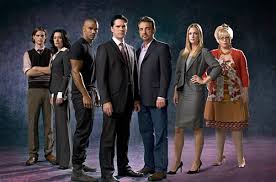
From left to right: Agents Reid, Prentiss, Morgan, Hotch, Rossi, J.J, Garcia. Not Pictured: Gideon and Elle
Want to read The Why? Click here!
